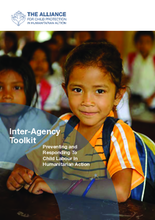Every day, millions of children worldwide experience the consequences of violent conflicts, climate change, disasters and epidemics. In times of crisis, when people are forced to flee their homes, schools close, jobs are lost and the availability of services decreases, child labour becomes a coping mechanism for many families in distress. It deprives children of their childhood, their potential and their dignity. Some of the worst forms of child labour, such as trafficking and commercial sexual exploitation, disproportionately impact girls. Others, such as hazardous work, cause often life-threatening harm to children’s health and wellbeing.
Given the immediate danger and long-term consequences of child labour, tackling it must be an urgent priority for all those working before, during and – crucially – after humanitarian crises. Strengthening both informal and formal systems and services that will continue to protect children from child labour after the emergency is over is essential. Child protection actors play a central role, but actors across many other sectors must also prioritise the issue if we are to effectively prevent and respond to the problem. Humanitarian efforts must ensure that they are not genderblind but respond to the unique needs of girls, who are more commonly involved in “hidden” and unregulated forms of labour such as domestic work. Despite this, girls are all too often overlooked in data that over-represents boys. Failing to apply a strong gender lens to child labour will leave millions of girls behind and increase their invisibility in humanitarian action.
The Inter-Agency Toolkit: Preventing and Responding to Child Labour in Humanitarian Action offers a strong global commitment to addressing child labour in humanitarian action. It was developed by the global Child Labour Task Force, under the Alliance for Child Protection in Humanitarian Action, which is co-led by Plan International and the International Labour Organization (ILO). The toolkit is an example of large-scale inter-agency and inter-sectoral collaboration: over 150 individuals from more than 30 agencies worldwide have helped develop and test the guidance and tools and shared best practice. The toolkit complements the 2019 Edition of the Minimum Standards for Child Protection in Humanitarian Action and seeks to form an evidence base for child labour programming in humanitarian settings, reflecting the great progress made over the past years.
Building on the universal ratification ILO Convention No. 182 on the Worst Forms of Child Labour and 2021 as the International Year for the Elimination of Child Labour , this innovative toolkit identifies the risks of child labour in humanitarian action, as well the importance of quality prevention and response programmes. Of the estimated 152 million girls and boys in child labour, many have been unnecessarily separated from their families with little or non-existent contact, especially for children on the move or in irregular migration. Many of these children lack identity documents, which makes the process of age verification and access to basic services challenging. As such, the tool on age verification is particularly helpful, as well as the other tools.
Learn more about the toolkit and accompanying materials here.

